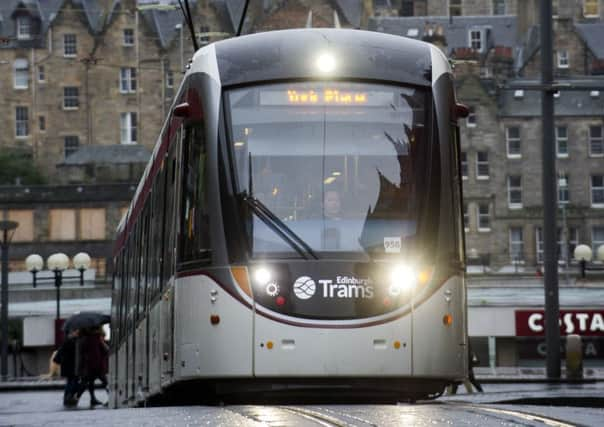Kenny MacAskill: Extending tram line essential even if it was a mistake in the first place


It’s time to move forward with a line that currently terminates in the middle of a main street leaving tourists bewildered, even if delighted at the view on route. Lugging suitcases across a busy roundabout to get a taxi or find out where they are. It’s a tram stop, not a tram terminus.
As with the construction it hasn’t been easy but as the saying goes we are where we are. Going back and ripping up the lines isn’t sensible and staying as things stand impractical, as fare box revenue is limited and subsidies are mounting. Proceeding forward with caution has to be the maxim for the tram on the line, as well as those in overall charge of the project.
Advertisement
Hide AdAdvertisement
Hide AdI opposed the project as it was the wrong time, the wrong scheme and the wrong route. The cost was always going to be scandalously high. There were other transport projects both within Scotland and the capital that were more essential and would have been more worthwhile. This wasn’t just Edinburgh centric but for a very small part of it. Most areas derived no benefit from it whatsoever but were to pay the price for it all the same.
Other cheaper options to improve transport existed. I recall being told that for the cost of the trams, every bus in Lothian could have been upgraded to a low emission high quality one and every route in Edinburgh operated free for five years. Whilst that was never going to happen, lowering the cost and increasing routes and frequency on the bus service seemed a better option. Orbital routes allowing for easy exchange and avoiding going into the city centre to get a bus out again, could have been more widely promoted, as opposed to increased fares and a threat to Lothian Buses, as the trams have posed.
Moreover, the tram route chosen wasn’t even the best option. Most successful tram routes in cities I’ve visited whether Helsinki, Munich or elsewhere operate on taking people from the peripheral housing estates they live in to the city centre or other industrial sites they work at. This route was chosen, it seems on a cost basis, as disused railway lines afforded cheaper construction costs. Hence leafier suburbs with low density population and limited public transport use were provided for. Meanwhile, an alternative option that would have provided access by a tram line to the Royal Infirmary, where easy access is absolutely required not just for the city but well beyond, as well as high density housing schemes like the Inch and Craigmillar, was rejected.
It came at a price both financial and personal. The price spiralled as it always would. The information on underground cables was always lacking and problems were bound to arise. Moreover, many businesses suffered horrendously during construction and were brought almost to their knees. The rates reduction in no way offset the business loss sustained for months and in some instances, they never recovered.
Of course, there’s an enquiry that will add to the entire cost of the project but likely shed little more light. Maybe a few minions will be sacrificed as with the Holyrood Enquiry but the political mistakes will be passed by. It was a vanity project which an outgoing Labour council signed up for in haste. Committing to it before seeking contributions from developers, never mind reading the small print. An incoming minority SNP administration was forced to back pedal on its implacable opposition for Green support. Labour/Tory/Libs and Greens then united to force the £500 million cost upon the new regime. West of Scotland Labour and Tory MSPs joyously celebrated not the scheme but the funds they’d forced to be spent.
But, it’s here now. It’s inconceivable to tear up the tracks. But, the current route is inadequate to provide for patronage as recent information disclosed. Fine if you’re going to the airport or Edinburgh Park from the city centre or in reverse. Though for many heading there, it’s by bus, taxi or car as the journey into the city centre negates any benefit of a tram. Murrayfield as an event centre is also benefitting. Fare box takings are limited and the bus network is expected to subside the loss, rather than be used to promote more routes, better services or even lower fares. The worry that trams would run down an outstanding bus service, is a danger fast approaching.
Extending the line is therefore essential to increase passenger usage and reduce the drain on the public transport service. Much of the pain in areas has already been taken and getting it to Ocean Terminal or preferably Granton, not as difficult or costly as once was. Given the population density along that part of the route, never mind the work and social attractions provided for, it can increase usage significantly.
How though is it to be paid for? The Scottish Government won’t pay for it. The council lack the funds for it. A council tax increase won’t meet it, nor should it. The only solution is some form of new levy that can be hypothecated for it. That could be a work place parking charge or a small inner city congestion fee to improve access and protect the historic environment of the Old Town. Though, not the insane proposal previously voted upon and comprehensively rejected.
Advertisement
Hide AdAdvertisement
Hide AdIt’ll be for the new council to decide but stalling isn’t an option as it will threaten not just the tram but the bus service the city prides itself on. Proceeding forward with caution is the only option.